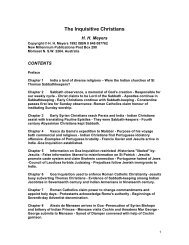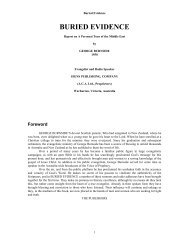Battle of the Bibles - Present Truth
Battle of the Bibles - Present Truth
Battle of the Bibles - Present Truth
Create successful ePaper yourself
Turn your PDF publications into a flip-book with our unique Google optimized e-Paper software.
BATTLE OF THE BIBLES 2<br />
H. H. MEYERS<br />
Chapter Eighteen<br />
The Schemers<br />
Unlike Erasmus, who had constructed his Greek New Testament from <strong>the</strong><br />
Traditional Text line, as handed down from <strong>the</strong> apostles through <strong>the</strong> churches in <strong>the</strong><br />
wilderness, Westcott and Hort went for Eusebius' Greek Bible. Jerome had replaced<br />
Eusebius' with a Bible in Latin.<br />
Among <strong>the</strong> fifty copies <strong>of</strong> this Bible ordered by Constantine it is reasonably<br />
assumed two have survived to this day, simply because <strong>the</strong>y were written on durable<br />
vellum and also because <strong>the</strong>y fell into disuse when Jerome's Bible was adopted by<br />
Roman Catholicism some sixty year later (See "Our Authorised Bible Vindicated", p<br />
248).<br />
Of <strong>the</strong>se manuscripts, one has survived for centuries locked up in <strong>the</strong> recesses<br />
<strong>of</strong> <strong>the</strong> Vatican. There it remained in seclusion until "rediscovered" in 1844. Ano<strong>the</strong>r<br />
survived <strong>the</strong> ravages <strong>of</strong> time, protected by <strong>the</strong> dry air <strong>of</strong> <strong>the</strong> Sinai desert. It was<br />
rediscovered in 1859 amongst <strong>the</strong> rubbish <strong>of</strong> <strong>the</strong> St Ca<strong>the</strong>rine Monastery at <strong>the</strong> foot <strong>of</strong><br />
Mt Sinai. It had been tossed out by some monk who obviously regarded it as worthless<br />
junk.<br />
These two Origen-impregnated manuscripts have been named Vaticanus (or B)<br />
and Sinaiticus (or "Aleph"). Westcott and Hort seized on <strong>the</strong>se Greek New Testaments<br />
as a basis for <strong>the</strong>ir work for very good reasons. One is that <strong>the</strong> Origenism with which<br />
<strong>the</strong>se manuscripts are impregnated, suited <strong>the</strong>ir modernist philosophy and ritualistic<br />
desires.<br />
Ano<strong>the</strong>r circumstance which Westcott and Hort could turn to <strong>the</strong>ir advantage was<br />
<strong>the</strong> fact that, although <strong>the</strong>se manuscripts are believed to be two <strong>of</strong> <strong>the</strong> fifty<br />
commissioned by Constantine, <strong>the</strong>y were so corrupted that <strong>the</strong>y differed significantly in<br />
over three thousand places in <strong>the</strong> Gospels alone 12 So, by using an eclectic method,<br />
<strong>the</strong>se two schemers could choose from ei<strong>the</strong>r manuscript <strong>the</strong> reading that best suited<br />
<strong>the</strong>ir philosophy. Fur<strong>the</strong>rmore, whereas <strong>the</strong> Rheims-Douay Bible was not radically<br />
different from <strong>the</strong> King James Version, <strong>the</strong>y could now produce a Greek New Testament<br />
as an "authoritative" basis for a "revised" Bible that would bring forth a totally new<br />
translation, which would not only please Rome, but would also appeal to <strong>the</strong> ritual-loving<br />
modernistic apostates <strong>of</strong> Protestantism. 13 The finished Bible would be fur<strong>the</strong>r from <strong>the</strong><br />
Received Text than <strong>the</strong> Rheims-Douay Bible.<br />
(12 Hoskier cited in "Which Bible" p 136.)<br />
(13 To this day, we see well meaning Protestants appealing to this corrupt text <strong>of</strong><br />
Westcott and Hort as though it were a faithful translation <strong>of</strong> <strong>the</strong> original Greek!)<br />
Again, by using <strong>the</strong> Vaticanus and Sinaiticus, <strong>the</strong>y could claim that because<br />
<strong>the</strong>se manuscripts date back to around 331 AD, <strong>the</strong> revision would be given credibility by<br />
virtue <strong>of</strong> <strong>the</strong> supposition that <strong>the</strong> older <strong>the</strong> manuscript, <strong>the</strong> more likely it would follow <strong>the</strong><br />
autographs.<br />
But, as we have seen, this <strong>the</strong>ory is a fallacy on two counts. Firstly, older is not<br />
necessarily purer; and secondly, <strong>the</strong> Waldensian <strong>Bibles</strong> were <strong>of</strong> <strong>the</strong> Antiochan-Itala<br />
1





